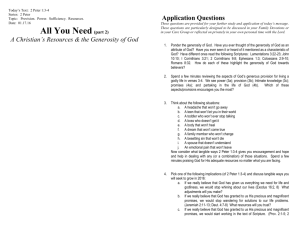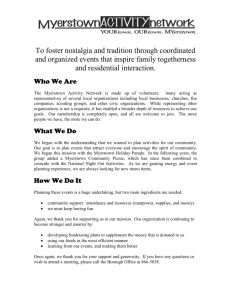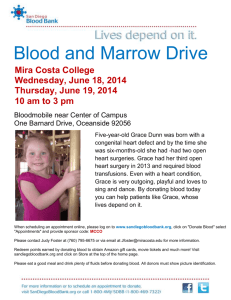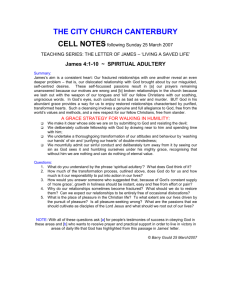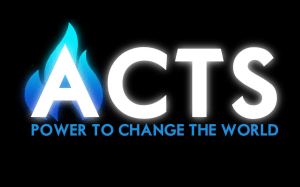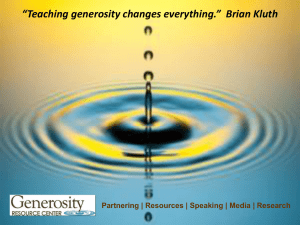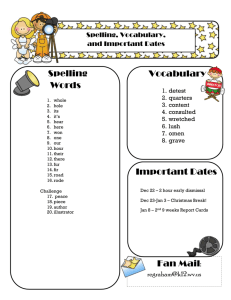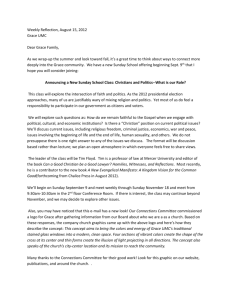Entire Workshop - Unitarian Universalist Association
advertisement
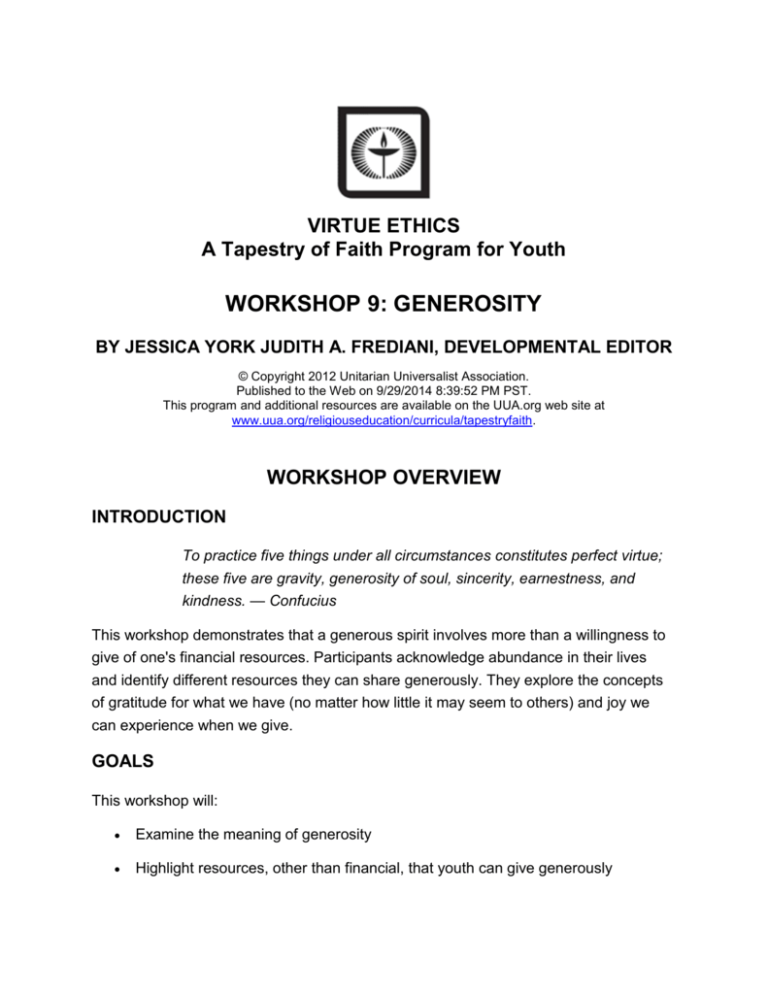
VIRTUE ETHICS A Tapestry of Faith Program for Youth WORKSHOP 9: GENEROSITY BY JESSICA YORK JUDITH A. FREDIANI, DEVELOPMENTAL EDITOR © Copyright 2012 Unitarian Universalist Association. Published to the Web on 9/29/2014 8:39:52 PM PST. This program and additional resources are available on the UUA.org web site at www.uua.org/religiouseducation/curricula/tapestryfaith. WORKSHOP OVERVIEW INTRODUCTION To practice five things under all circumstances constitutes perfect virtue; these five are gravity, generosity of soul, sincerity, earnestness, and kindness. — Confucius This workshop demonstrates that a generous spirit involves more than a willingness to give of one's financial resources. Participants acknowledge abundance in their lives and identify different resources they can share generously. They explore the concepts of gratitude for what we have (no matter how little it may seem to others) and joy we can experience when we give. GOALS This workshop will: Examine the meaning of generosity Highlight resources, other than financial, that youth can give generously Explore situations where generosity is used or called for Guide youth to identify themselves as generous people. LEARNING OBJECTIVES Participants will: Explore the meaning of generosity Discuss dilemmas where generosity is needed Identify times they have used generosity and commit to the future use of generosity in their lives. WORKSHOP-AT-A-GLANCE Activity Minutes Opening 10 Activity 1: Story — The Other Half 10 Activity 2: Two Sides to Every Virtue 10 Activity 3: What Have I Got to Give? 15 Activity 4: A Generous Spirit 15 Activity 5: Dilemma 10 Activity 6: Practice 15 Faith in Action: Gleaning Closing 5 Alternate Activity 1: Real Life Challenges Alternate Activity 2: Grace 30 SPIRITUAL PREPARATION At which are you better, giving or receiving? Some people love to give, but are less comfortable receiving from others. If this is the case with you, think of a time you gave away something, although you did not possess it in abundance. How did that feel? Did you feel liberated? Did you feel generous? Did your act give you joy? Holding that feeling, imagine someone giving something to you—a resource you lack. Perhaps someone shown patience with you, when you were impatient with yourself, or shared wisdom with you exactly when you needed it. Imagine the giver being filled with that sense of liberation, that joy. Realize that by graciously receiving their generosity, you enabled these wonderful feelings. Now think about the kind of giver you are. Is there something you have been called on to give, but of which you cannot let go? Are you debating stepping up to accept a position of leadership? Are letters from charities piling up on your desk? Imagine yourself giving this resource away. Could your giving transform someone's life? Imagine their joy. Imagine your feeling of liberation. Imagine your soul's capacity for generosity growing, as you focus on abundance instead of scarcity. Balance the benefits with the real possible consequences. What is the worst that could happen? How would you survive it? Would the risk be worth the potential gain? Only you can decide. The trick is to make sure your choices reflect your values. WORKSHOP PLAN OPENING (10 MINUTES) Materials for Activity Newsprint, markers, and tape Chalice, candle, and lighter or LED battery-operated candle Group covenant (Workshop 1) Optional: Bicycle Rack newsprint sheet (Workshop 1) Optional: Alternate Activity 1, Real Life Challenges (included in this document) Preparation for Activity Read Alternate Activity 1, Real Life Challenges. Prepare to incorporate it into this Opening, if you think you will have time and you observe that youth want to discuss challenges shared in their check-in. Post the chalice lighting words. Post the group covenant. Post the Bicycle Rack sheet the group began in Workshop 1, Opening, or label a new sheet of newsprint "Bicycle Rack," and post. Description of Activity Invite a volunteer to light the chalice while you lead the group to recite the chalice lighting words: The thought manifests as the word The word manifests as the deed; The deed develops into habit; And habit hardens into character; So watch the thought and its ways with care, And let it spring from love Born out of concern for all beings... As the shadow follows the body, As we think, so we become. — from the Dhammapada, Sayings of the Buddha Invite the youth to check in by sharing any moral challenges they have experienced since the last meeting. If appropriate, use Alternate Activity 1 to further explore the group's challenges. If youth appear interested in discussing a particular challenge but you feel there is not enough time in this meeting, ask the person who shared it to write a short description of the challenge on the Bicycle Rack. Tell participants that today you will talk about generosity. ACTIVITY 1: STORY – THE OTHER HALF (10 MINUTES) Materials for Activity Story, “The Other Half (included in this document) ” Preparation for Activity Read the story and prepare to present it. Optional: Copy the story for all participants. Description of Activity Youth hear and discuss a true story about a family’s generosity. Introduce the story by saying it is true. Tell or read the story, then discuss it with these questions: The Salwen family’s generosity amounted to one million dollars, half the value of their mansion. Did they sacrifice to give such a large sum of money, and, if so, what did they sacrifice? What else did the Salwens give besides money? What did they gain by giving? Tell the group The Power of Half (New York: Houghton Mifflin Harcourt, 2010) is a book written by the father and daughter. The dad tells the story, interspersed with suggestions from Hannah on ways readers can engage with this work. One suggestion is to consider what can you give away half of. For the Salwens, it was a house. Hannah gives a couple of suggestions, including giving away half your clothes to a second-hand shop. Ask: Could you do this? Which half would you give away? What other suggestions do you have for resources you might cut in half and then give half away? Conclude: This experiment caused the Salwens to view generosity in a new way. Though they were already donating to charities and helping out in soup kitchens, they decided it was not enough. How do you know when you are giving enough to make the world better? ACTIVITY 2: TWO SIDES TO EVERY VIRTUE (10 MINUTES) Description of Activity Participants identify positive and negative aspects of the virtue of generosity. Invite youth to sit for a moment and think about generosity as a virtue. These prompts might be useful: What have you been told about generosity: What it means, when to use it, when not to use it? What have you been told about stinginess? What is the difference between being “frugal” and being “stingy?” What resources do you have that you could be generous with? Does the amount of resources you have influence how generous you might be? How do you measure your generosity, especially if what you are giving is not money? What “amount” are you comfortable with in different situations? Is there anyone you admire who is generous? In what way do they live out their generosity? Has being generous ever backfired on you? What other questions come to mind when you think about generosity? Invite youth to share their reflections, with statements that start “On the positive side…” or “On the negative side…”. For example, “On the positive side, I feel liberated when I am generous with my money. I feel it reflects my commitment to value people more than possessions.” Or, “On the negative side, some people are always giving things away: money or possessions. When someone gives to me more than I feel I can give back, I feel indebted and I resent that.” Do youth have statements that do not fit either clause? Discuss these as a group. Make sure these points are discussed: Sometimes a situation can be positive when looked at one way and negative another. Do moderation and balance have a place here, too? Is there such a thing as being too generous? If so, where is the line drawn? Who draws it? ACTIVITY 3: WHAT HAVE I GOT TO GIVE? (15 MINUTES) Materials for Activity Newsprint, markers, and tape Preparation for Activity Draw the outline of a person on newsprint, and post. Description of Activity Youth consider diverse ways to be generous. Say in these words, or your own: Often, when we talk about generosity, we limit ourselves to thinking of money only. Giving financially to organizations and people who are trying to help the world be a more just place or to people who have material needs is important, but it is not the only way we can be generous. Ask the group to brainstorm resources with which we can be generous. Make sure they include: our time, our talents or expertise, our knowledge, our heart (loving generously), and our support or enthusiasm. Write, or have a volunteer write, each suggested resource on the newsprint in an appropriate place on the body. For example, they might write “knowledge” on the head. Let the resources be as general or specific as the youth like. Now invite participants to think quietly for one minute of a time someone was unexpectedly generous to them with a resource other than money. After one minute, have the youth partner with one other person and share their stories. Give pairs four minutes, telling the pairs when two minutes have passed and they should switch speakers. Re-gather the group. Ask a few volunteers to share their own story with the entire group. In each story, help the youth identify what resource was given. Ask the storyteller how it felt to be the recipient of such generosity. Remind the group that during the Practice activity, they will be asked to find an area of their life where they could be more generous. Point to the brainstormed list and say that generosity is not about having a lot of money to give away. It is about having a generous spirit or soul. ACTIVITY 4: A GENEROUS SPIRIT (15 MINUTES) Materials for Activity Chalice and centering table Candles for all participants (including leaders), and a lighter, or LED/batteryoperated tea lights for all participants Story, "The Gift of a Gemstone (included in this document) " Handout 1, Litany of Generosity (included in this document) Preparation for Activity Plan how you will engage the youth in a worship experience. Youth might read the chalice lighting, read the story, open a reflection, read parts in the Litany of Generosity (Handout 1), and/or each light a candle. Assign reading parts to volunteers ahead of time, and give them their parts in advance. Copy the handout for all participants. Set the chalice and the candles or tea lights on a centering table, with the chalice. Description of Activity Youth explore generosity as a spiritual practice. Invite the youth to participate in worship with you. Assign volunteer roles you have not yet assigned. Distribute handouts as needed. Gather the group around the chalice. If it has been extinguished, relight it with these words by Jacques Yves Cousteau: It takes generosity to discover the whole through others. If you realize you are only a violin, you can open yourself up to the world by playing your role in the concert. Tell or read the story “The Gift of a Gemstone.” Invite participants to reflect silently on gifts transformed: Has there been a time they gave away something that was insignificant to them but of great value to someone else? Have they ever given a gift they assumed would be used in one way, but the recipient used it in another? How did they feel? Were they able to give freely and feel joyful for the recipient? After two minutes, invite volunteers to share. Indicate the candles or tea lights. Ask everyone to join in the litany. Explain who will read which lines and how you would like the group to light the candles. For example, you might have volunteers each read a line in the litany, then light a candle. Have youth without a reading part each light a candle during the refrains that start, “Spirit of Life and Love…” or invite them to add their own line to the litany. Including All Participants Arrange the space for this worship so everyone can meaningfully participate. A youth with mobility limitations could have a partner light their candle while they read a line of the litany. Do not put any youth on the spot to read aloud. ACTIVITY 5: DILEMMA (10 MINUTES) Materials for Activity Leader Resource 1, Generosity Dilemmas (included in this document) Preparation for Activity Print the Leader Resource for yourself and volunteer readers. Description of Activity Youth discuss scenarios involving ethical dilemmas. Seek a volunteer to read one of the two scenarios. Open the floor to reactions and answers. For each dilemma, ask participants if this reminds them of another dilemma they have encountered or heard of, real or fictional. Ask, “How could generosity be expressed in this dilemma?” ACTIVITY 6: PRACTICE (15 MINUTES) Materials for Activity Newsprint, markers, and tape Participants’ journals, and writing instruments Participants’ clipboards with anklets (Workshop 1, Activity 3, Practice) Beads, and waterproof markers and/or other decorations Extra clipboards and string/hemp, and scissors Preparation for Activity If needed, read instructions for making the anklets in the Before You Start section of the program Introduction and in Workshop 1, Decision Making. Retrieve participants’ clipboards with anklets, and participants’ journals if these are also kept on-site. Write on newsprint, and post: o When was a time you felt your actions were generous? o What made it possible for you to be generous in this instance? o Have you ever experienced a situation where it would have been helpful to me more generous? o In what areas of your life now could you use generosity to help you be the person you want to be? Description of Activity Participants understand how the use of generosity affects their lives. Invite youth to take five minutes to journal, using the questions on newsprint as prompts, or to draw or meditate on the questions. Remind participants one can be generous with many different resources, not just money. For example, you can give your time, your talent, your feelings, or your knowledge. Additional prompts you may add, while the group journals: What can I uniquely share with my community (family, friends, congregation, city, world)? Whose generosity have I not acknowledged? Whose generosity do I admire? Why? Do I use one type of generosity too much because I am afraid or unwilling to give of myself in other ways? Invite participants to share journal writing to their level of comfort. You may wish to remind youth that you are a mandated reporter and, if anyone discloses behavior that could be dangerous to themselves or others, you will need to report it. Listen to what is said. If needed, guide the group toward concrete examples of practicing the virtue of generosity in real life. If remarks seem too abstract, challenge youth to create specific “to do” items based on their reflections. Distribute participants’ clipboards, new beads (one per youth), and decorating materials. Invite youth to decorate a bead while reflecting on their personal experiences with generosity. Remind them that the beads will act as a reminder to use their highest values. As participants finish, have them add this bead to the anklet they started in Workshop 1. If any participant missed Workshop 1, provide them with a clipboard, hemp, a bead for their name bead, and instruction to begin their anklet. Collect journals, clipboards, and anklet-making materials, and store for the next workshop. CLOSING (5 MINUTES) Materials for Activity Chalice, candle, and lighter or LED battery-operated candle Taking It Home (included in this document) Preparation for Activity Adapt the Taking It Home section and copy for all participants. Optional: Print the closing quotation (below) for a volunteer to read. Description of Activity Have a volunteer read the quotation while another extinguishes the chalice: It takes generosity to discover the whole through others. If you realize you are only a violin, you can open yourself up to the world by playing your role in the concert. — Jacques Yves Cousteau Distribute Taking It Home. FAITH IN ACTION: GLEANING Materials for Activity Supplies for gleaning work—for example, gardening gloves or latex gloves; bags, baskets, or other approved containers; sturdy shoes Optional: A computer with Internet access Preparation for Activity Does the Society of St. Andrew (at www.endhunger.org/) have a branch in your community? If so, organize your gleaning trip through them. If not, research groups in your area that do gleaning or food recovery work and will accept the youth as volunteers. Determine if a representative of the organization can speak to youth about local hunger issues. If no speaker is available, prepare to present from the Internet site of the group you are working with or to print out materials to share. Find out how the youth should equip themselves for this project. Make arrangements to bring any needed supplies. Make plans for a service project the youth can do. Research current information on hunger in the world, the U.S., and your community. Two websites that might help are the World Food Programme (at www.wfp.org/hunger/stats) of the United Nations and Food Research and Action Center's list of states' anti-hunger organizations (at frac.org/state-news/state- anti-hunger-organizations/). If you will have a guest speaker, ask them to include this information: It is important youth know why they are providing service and to whom. Make sure this part of the activity includes telling youth where and how the recovered food will be used. Description of Activity The group works with an agency whose mission is to alleviate hunger locally. Present information on the Society of St. Andrew. If you have Internet capability, have the youth peruse the Society of St. Andrew (at www.endhunger.org/) website. If you have the option to work with different groups, present information about all the options and let the group decide which organization best suits their needs. Explain that "gleaning" is a process where fields that have been harvested are picked over for any small remains. Gleaning appears in the Hebrew scriptures, where farmers are commanded to leave the corners of their land unharvested so the hungry can come and glean food they need. Modern day gleaning includes working with farmers who have leftover produce they cannot sell and bringing that produce to people who are hungry, sometimes through food recovery agencies that package food to distribute, other times through soup kitchens. Once you choose an organization, arrange a date to glean. Arrange for a representative of the organization to talk to the youth beforehand about local hunger issues. Make sure you have information on how the food gleaned will be used. If possible, involve the youth in delivering the gleaned food. Including All Participants Inform the organization you will work with about accessibility needs of your group. LEADER REFLECTION AND PLANNING Reflect on the workshop with your co-leader. Which activities did the group enjoy most? Were varied learning styles addressed? Are group dynamics taking shape in a healthy way or are there issues you should address? Did participants keep to the covenant? Do co-leaders feel the work is shared equally? Did you have fun? Read the next workshop for any advance preparation needed and decide who will be responsible for what. TAKING IT HOME To practice five things under all circumstances constitutes perfect virtue; these five are gravity, generosity of soul, sincerity, earnestness, and kindness. — Confucius IN TODAY'S WORKSHOP... we discussed having a generous spirit, which allows one to be generous with all resources and gifts, not just money. We learned about the Salwen family, who sold their home and gave half the proceeds to a village in Ghana. The Salwens Read The Power of Half (New York: Houghton Mifflin Harcourt, 2010). It offers great suggestions from the daughter, Hannah, on how to grow a more generous spirit. Watch this excerpt (at abcnews.go.com/WNT/video/14-year-teaches-family-power-half9782067) from an ABC television interview. Living with Less Generous can mean giving away extra. It can also mean living with less. With today's threats to our environment, people in affluent countries need to learn to live with less. By moving to a smaller home and working together for a common, long-range goal, the Salwens rediscovered the joy of spending time together as a family. Discuss with your family ways you could live with less. What could be some benefits of doing so? Giving up a resource can be liberating. Perhaps another way to ask this question is to ask, "What would you like to liberate?" What Do You Have That You Can Give? Need assistance to analyze the gifts and talents you could share with the world? The Time and Talent survey created by the UU Society of Geneva (Illinois) (at content.uusg.org/time-talents-interest-invento/)might help you decide. An online survey (at www.vasynod.org/files/StewardshipHandbook/CHAP08.pdf) from the Evangelical Lutheran Church asks detailed questions. Want to recognize someone's birthday or special occasion, but lack funds? Give a service IOU. Give your sibling a coupon good for one bedroom cleaning. Give your best friend an IOU promise to go see a movie you do not want to see but they do. Hunger Invite family and friends to do the 30 Hour Famine (at 30hourfamine.org/) with you. This activity will help you start to understand what millions experience every single day. Seek sponsors for your famine and donate funds to a group that works to end hunger. ALTERNATE ACTIVITY 1: REAL LIFE CHALLENGES Materials for Activity "Bicycle Rack" newsprint sheet from Opening Description of Activity Youth discuss ethical challenges they have faced. If someone shared an experience in check-in or during any workshop activities that the group would like to explore further, do so now. This could be particularly useful if an experience resonated with many participants. If several challenges are already listed on the Bicycle Rack, invite the youth to choose one to discuss. It need not be related to this workshop's topic. You might use these questions to structure a discussion: What virtues could this challenge bring into play? Did this challenge involve a conflict of values? If so, what values? How do they conflict? What are possible solutions to this challenge? Are they equally good? Why or why not? Affirm that is always easier to see good solutions in hindsight and that living a life according to virtues we want to nurture or values we hold dear is not always easy. We do not need to always "get it right," but we do need to keep trying. ALTERNATE ACTIVITY 2: GRACE (30 MINUTES) Materials for Activity A treat—one for each youth For swans: Paper for origami, 6-inch squares in different colors Handout 2, Grace Reflections (included in this document) Handouts 3-7, Origami Instructions – Swan (included in this document) Optional: Music, and music player Optional: For doves: 8-inch diameter paper dollies Optional: A computer with Internet access, and a digital projector or large monitor Preparation for Activity Print Handout 2 and Handouts 3-7 for all participants. Optional: Choose music that evokes generosity of spirit. Test the music player. Optional: If you will have Internet access, plan to show a video on how to fold an origami dove or origami swan. One simple, short dove origami video is posted by Lisa Shea (at www.youtube.com/watch?v=TKZY1Xusw6w). Here is one for a swan, by Howcast (at www.youtube.com/watch?v=_U-pYvBNAQQ) and another, longer, more complex swan posted by Rob (at www.youtube.com/watch?v=f0zTNCRg-Uc). Description of Activity Youth grapple with the religious concept of grace. Present the treat to the group. The treat could be edible, such as cups of sherbet, or inedible, such as small, attractive stones, pieces of amethyst, or dollar store gifts. Ask the group if they know the occasion for the gift. After guesses, tell them you gave it to them “just because.” Ask if anyone has ever given them a gift “just because” before. Seek volunteers to talk about the situations involving the gifts. Focus on how it felt to be given something they did not expect, possibly did not even feel they deserved. Distribute Handout 2 and read the definition of grace from Babcock, a Christian scholar. The Christian concept says that humans are saved not because they are good but through God’s grace, which comes from God’s great love. It is God’s grace that allowed Jesus to be born a man, suffer, and die for human salvation. Can the concept of grace have meaning for non-Christians? Read the Unitarian Universalist quotations from the Handout. Then, lead a discussion with these questions: Do any of these definitions resonate with you? Chance Hunter gives examples of small acts of grace. Have you ever had experiences like the ones he describes? Does the gift have to be something materialistic? Can you think of a time you received a non-material gift that was unasked for and undeserved? For example, has a teacher ever surprised them with a gift of “no homework?" Invite participants to think of ways they could be generous and give the gift of grace. Ask them to think of someone who would benefit from knowing they are thinking of them. Perhaps it is someone they witnessed doing a quiet act of kindness, or someone dealing with illness or hardships gracefully. They might want to give them a swan. Another option is folding an origami dove for someone whose life seems particularly stressful and chaotic at the moment. Distribute Handouts 3-7, Origami Instructions – Swan, and paper for folding. If you have Internet access, show the instructional video(s). Be ready to stop and start the video to allow everyone to move at their own pace. If you are not using instructional videos, or after the videos are finished, play music you have brought while youth fold animals. VIRTUE ETHICS: WORKSHOP 9: STORY: THE GIFT OF A GEMSTONE A wisdom tale from many cultures, including Buddhist. A wise woman, a teacher, was passing through a forest. There, among the leaves, was something shiny. She wiped away the leaves and dirt and beheld a beautiful, large gem. "My, this is pretty," the wise woman said. She put the jewel in her pouch and continued on her way. When the sun was high in the sky, she sat down under a tree to eat her simple lunch. She was barely settled, when she saw a figure approaching. It was a man and, to judge from his dress, a poor man. "Kind and gentle lady, do you have any food to share with a poor beggar?" "I have plenty," she replied with a smile, digging into her small sack. She pulled out the gem that was on top, a loaf of bread and a piece of cheese. She offered the bread and cheese to the beggar. But the beggar's eyes had grown big at the sight of the lovely gem. "Sweet lady, that is a magnificent jewel!" he exclaimed. "Yes, do you like it? Here, take it, too." And she gave the man the gem, the bread, and the cheese. The beggar could not believe his luck! He wrapped the gem in his cloak and quickly scampered off. The wise woman arose and started off on her way again. She was surprised a few minutes later to hear footsteps behind her. She turned and saw the beggar before her again. The beggar held out the jewel. "Wise woman, may I give this back to you. I don't want it!" "What do you want?" she asked. "I want whatever it is you have that allowed you to give it away." VIRTUE ETHICS: WORKSHOP 9: STORY: THE OTHER HALF Hannah Salwen looked left. She saw a man who was homeless, sitting on a fence. She looked right, at the Mercedes beside them at the intersection. "Dad," she said, "if that man"—she pointed to the Mercedes—"had a less nice car, that man there" —she pointed to the man who was homeless—"could have a meal." Hannah's father, Kevin answered, "Um, yeah. But you know, if we had a less nice car, he could have a meal." So began the saga of the Salwen family and how they learned you can give away millions, and still receive something greater in return. The Salwen family was sitting pretty. Kevin and Joan had successful jobs, with nice incomes and benefits. In 1994, they moved with baby Hannah to Atlanta and bought a historic home on Peachtree Circle. Joseph was born soon after. They went to church and believed in helping others. Joan chaired the United Way campaign at her workplace to collect money for charity. Kevin and Joseph built homes for Habitat for Humanity. Hannah spent many more hours at the soup kitchen than she needed to fill a community service requirement at school. They were, by most standards, good people. Yet, after the stop light epiphany, Hannah began to wonder if it was enough. She challenged the rest of the family to think bigger. The stakes were raised when Joan asked if they really needed their two million dollar mansion. This question led to a series of family meetings. Opinions flew fast and furious. "What is it you want to accomplish?" "Am I supposed to give up everything I own?" "How much do we really need?" After many discussions—some ending in anger, some in tears—the decision was made: They would sell their house, give half of it away to people in need, and move into a smaller home. One million dollars is a lot of money. More family meetings were called for to decide how and where to spend it. In the process, the Salwens made a discovery: They had drifted apart. Sports, time with friends, working late, electronic entertainment, and other distractions occupied so much of their time that quality time spent together was virtually nonexistent. Now that they were meeting to discuss how to spend "the half," they remembered how much fun they had together. They discussed topics that were meaningful. Brother and sister became closer. The family listened to presentations from several organizations eager to put their gift to good use. They picked The Hunger Project. There were complications. They committed to donating money, but their house was hard to sell. They had to repeatedly reduce the price. Now, the sale of the house would not amount to the money they pledged to donate. Family meeting. The decision? They would find ways to make up the deficit and stick to their original promise. In the end, the Salwens donated enough money to build a community center in Ghana. The Salwens traveled to Ghana to meet the people in the villages. They listened to the villagers decide what they could use the most. The new center included a mill that villagers use to grind their grain so they could sell it for more to other villages. There was space for a schoolroom for girls, and a clinic. This relationship has grown over the last few years to include another village and the Salwens have donated more than the original million, as they have discovered other sources to generate income for projects, including writing a book, The Power of Half. One dollar from each book sale goes to Rebuilding Together, which provides money for critical home repairs to low income homeowners. The Salwens keep giving. But they also want everyone to know that what they receive—the liberation from materialism, the joy of seeing other families pull themselves out of poverty—is more precious than gold. VIRTUE ETHICS: WORKSHOP 9: HANDOUT 1: LITANY OF GENEROSITY Spirit of Life and Love, Bless me with a generous heart A generous heart that knows how to give... When I feel as though I do not have enough to share, When I feel unappreciated, When I believe my gifts will fall short of what is needed, expected or desired, When my enemy is in need of mercy, whether asked for or not. Spirit of Life and Love, Bless me with a generous heart A generous heart that knows how to accept with grace... When I receive gifts that I fear are undeserved When I am forgiven by those I have hurt When I am hurting and comfort is received. Spirit of Life and Love, Bless me with a generous heart That I may give joyfully, Receive gratefully, And create loving kindness in my life and the lives of others. VIRTUE ETHICS: WORKSHOP 9: HANDOUT 2: GRACE REFLECTIONS Excerpts used with permission. "[Grace]... is God's granting Salvation not in reward for the moral worth of the human but as a free and undeserved gift of love." William S. Babcock, Christian scholar "To trust the context—the place in which we must live out our lives—to trust in spite of the chaos and the tragedy, rather than living in terror of what we have not made and cannot control—this is to live gracefully. To accept the givens of our personal existence and to act responsibly, to act purposefully, in trust, this is to achieve and to experience a state of grace, a graceful being. Yet I have not known anyone who has lived grace-fully who has not struggled to live in that way, struggled to learn from pain that has no meaning, and borne the cost of letting go and letting be. But, I assure you, there is grace. I have felt it at times engulf me, restore me, and bless me with a passing vision of harmony and balance. I do not believe that grace is a gift imposed on us from above. I believe that grace is a standing invitation, the universe outstretched as a hand we beat against until we are finally able to rest into it." Edward Frost (Unitarian Universalist minister) from "Amazing Grace (at clf.uua.org/quest/2008/07/frost.html)" an article in Quest (July/August, 2008), a Church of the Larger Fellowship publication. "So what is grace? Grace is getting more than we deserve. It's not winning the jackpot—winning the lottery is luck, not grace. Instead, grace is finding an unexpected moment of peace while taking a walk. Grace is learning something new and amazing about a friend you've had for years. We encounter grace when we hear a song by a group we've never heard of that changes our lives, or when we make a difference volunteering because we signed up and showed up. Grace can feel like a wave of relief or a spike of pain, but it always leads us in the path of more hope, more trust, more love. Grace is always there, waiting to happen. Grace is very patient. And polite. Grace never imposes itself. Grace can surprise us, but it doesn't force itself on us. Grace is a willing partner and a constant friend, but it never invades, even when our experience of grace feels overwhelming. This is at the core of the universalist message: There is always more than enough grace to go around. There's no amount of good deeds we can do, and there's no magic prayer we can pray, that will guarantee we receive grace. We receive grace, not because we deserve it, but because the universe is fundamentally a generous place... . Grace isn't just something we receive; it's also something in our power to give. In the early verses of the book of Genesis, it says that we are created in God's image. If it's the nature of God to give grace, then it's our nature, too. We are most like God when we are being graceful to one another, when we make room for the presence of another, whatever the consequences." Chance Hunter from "Grace wins in the end (at www.uuworld.org/spirit/articles/175315.shtml)" an article from UU World (Spring, 2011) VIRTUE ETHICS: WORKSHOP 9: HANDOUT 3: ORIGAMI INSTRUCTIONS — SWAN From the Origami-instructions website, www.origami-instructions.com. Used with permission. For swan: Fold the paper along one diagonal, then unfold it. Now fold the lower edges of the square into the centerline as shown. This is your kite base. Flip the kite base over. Next make a double fold as shown. Repeat on the other side. Fold the point of the piece upwards. Then fold the head of the swan downwards. Next, fold the swan in half as shown. Pull the neck of the swan away from the body, and unfold the head and body. VIRTUE ETHICS: WORKSHOP 9: HANDOUT 4: ORIGAMI INSTRUCTIONS — SWAN VIRTUE ETHICS: WORKSHOP 9: HANDOUT 5: ORIGAMI INSTRUCTIONS — SWAN VIRTUE ETHICS: WORKSHOP 9: HANDOUT 6: ORIGAMI INSTRUCTIONS — SWAN VIRTUE ETHICS: WORKSHOP 9: HANDOUT 7: ORIGAMI INSTRUCTIONS — SWAN VIRTUE ETHICS: WORKSHOP 9: LEADER RESOURCE 1: GENEROSITY DILEMMAS Dilemma 1 There are countless organizations through which you can give money to help those in need. How do you choose? Are children more worthy than animals? What criteria do you use? Does your family use the same criteria? Imagine walking into your congregation and seeing two tables. One is collecting money for Heifer, International; the other, for Greenpeace. Greenpeace endeavors to protect sea life and ecosystems. Greenpeace speaks out and stages actions to call attention to environments that are being endangered by human activity. You like that. However, sometimes, their tactics have been called unlawful, disrespectful, and even dangerous to human lives. Heifer gives animals and plants to people. You like that, too. But some vegetarians and vegans object because many of the animals are eaten. On the other hand, the animals are never given solely for food: All the animals (and plants) provide something the people can sell to increase their household incomes, like wool, milk, or eggs. The income has allowed many families to send children to school or send family members to doctors. You want to give a dollar bill. Neither table has change. Which do you choose and why? Dilemma 2 Do the means justify the ends? What if your bank made a mistake and deposited an extra $100 in your account. Which would be better: notifying the bank of its mistake or giving the money to charity? FIND OUT MORE Many organizations work to eliminate world hunger, including Hunger Project (at www.thp.org/), Freedom From Hunger (at www.freedomfromhunger.org/), Action Against Hunger (at www.actionagainsthunger.org/), and the Millennium Project (at www.millenniumpromise.org/).
